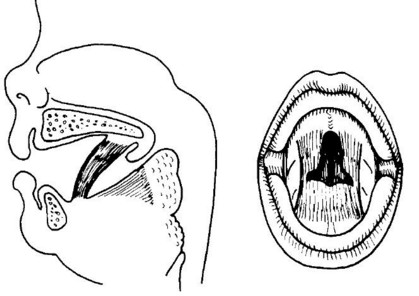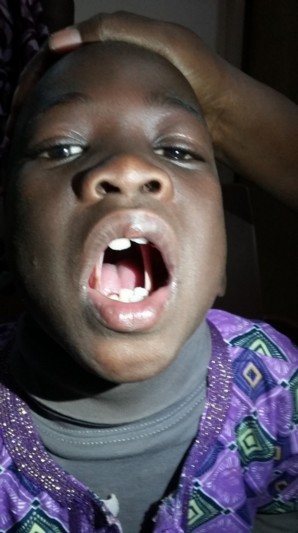(CPLSS)
Prevalence < 1/106. Dominant autosomal transmission. Association of a cleft palate and intra-oral lateral synechiae that can connect:
- the free edges of the palate to the floor of the mouth
- the tongue (frenulum or dorsal side) to the palate (bony or soft): in case of adhesion of the dorsal side of the tongue to the palate, it is called glossopalatal ankylosis (see this term)
- the gums of the upper and lower jaws: in case of complete fusion, it is a syngnathia (see this term).
The cause may be the persistence of the anterior or posterior part of the embryonic buccopharyngeal membrane (see oropharyngeal atresia), or the formation of ectopic membranes.

subglossopalatal membrane that is a remnant of the anterior part
of the buccopharyngeal membrane
Those synechiae can be asymptomatic or cause feeding problems when limiting mouth opening. This anomaly can occur in association with other congenital anomalies, specially in Van der Woude syndromes, orofaciodigital syndrome and popliteal pterygium syndrome.

Anesthetic implications:
in case of difficult breathing or feeding, it may be necessary to cut the synechiae in the neonatal period; otherwise, these fibrous bands are resected at the time of the repair of the cleft palate and can be used to reconstruct the soft palate. Risk of difficult laryngoscopy. Risk of temporomandibular ankylosis in case of late surgical repair: ideally, nasotracheal intubation with a fibroscope. Some patients have been successfully intubated using the retromolar (paraglottic) approach, sliding the laryngoscope blade between a palato-lingual adhesion and the alveolar arcade.
References :
- Gartlan MG, Davies J, Smith RJH.
Congenital oral synechiae.
Ann Otol Rhinol Laryngol 1993; 102: 187-97.
- David LR, DeFranzo AJ, Argenta LC.
Oral synechiae: unusual initial asymptomatic presentation in four cases.
Eur J Plast Surg 1995; 18: 255-7
- Ogino A, Onsish K, Maruyama Y.
Congenital oral synechia associated with cleft palate: cleft palate medial synechia syndrome ?
Eur J Plast Surg 2005; 27: 338-40
- Sunder RA, Manikandan R, Kumar M.
Airway management of a neonate with a rare congenital palatoglossal synechiae.
Pediatr Anesth 2008; 18: 980-2
- Batra YK, Rakesh SV, Menon P, Rao KLN.
Successful airway management with left-molar laryngoscopy in glossopalatal ankylosis: a case report.
Acta Anaesth Belg 2010; 61: 215-6
- Mukharjee S, Mitra D, Sen A, Chattopadhyay A, Kajal S, Dhankhar M.
Intubation of a neonate with glossopalatine ankylosis using a paraglossal approach and a laryngoscope with a straight blade.
S Afr J Anaesth Analg 2014; 20: 218-9
- Rai A, Bhola N, Yadav A, Sheorain A, Datarkar A, Joju S, Borle R.
Intraoral epithelial bands in a newborn: report of two cases and review of literature.
J Maxillofac Oral Surg 2012; 11: 351-3.
- Jash PK, Chattopadhyay D, Rampuri V, Ahmed F.
Cleft palate with lateral oral synechiae presenting in late childhood: an extreme rarity.
J Cleft Lip Palate Cranioafacial Anomal 2015; 2: 133-5
- Mascarella MA, Schwartz J, Manoukian JJ.
Congenital intra-oral adhesions : a surgical approach to cleft palate lateral synechiae syndrome.
Int J Pediatr Otorhinolaryngol 2015 ; 79 : 769-72.
- Ho T-VT, Weatherly RA, Kaye AE.
Oral synechiae : a case presentation of airway and surgical management.
Int J Pediatr Otorhinolaryngol Extra 2016 ; 12 : 7-9
- Denion E, Capon N, Martinot V, Pellerin P.
Neonatal permanent jaw constriction because of oral synechiae and Pierre Robin sequence in a child with Van der Woude syndrome.
Cleft Palate-Craniofac J 2002 ; 39 : 115-9
Updated: February 2020